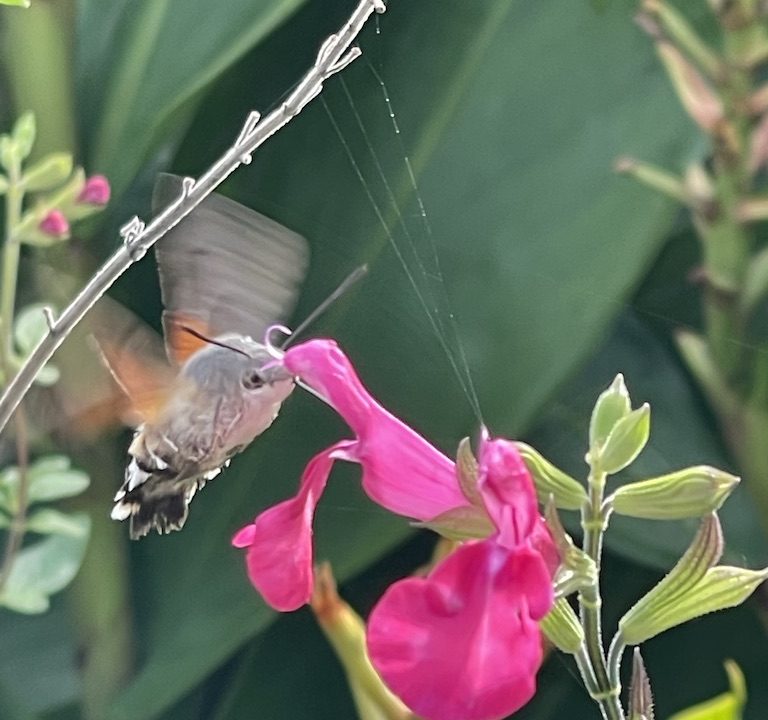Good Bug, Bad Bug
I hope that by the time this article comes out we will have had a few days of summer weather to encourage us outside to look closely at the bugs in our gardens – good and bad.
The balance between good and bad is the major point here with a plea to use specific controls of individual pests rather than using non-specific insecticides that impact our already depleted bio-diversity.
Here is a small selection of the bugs I see in my garden.
Good bugs:
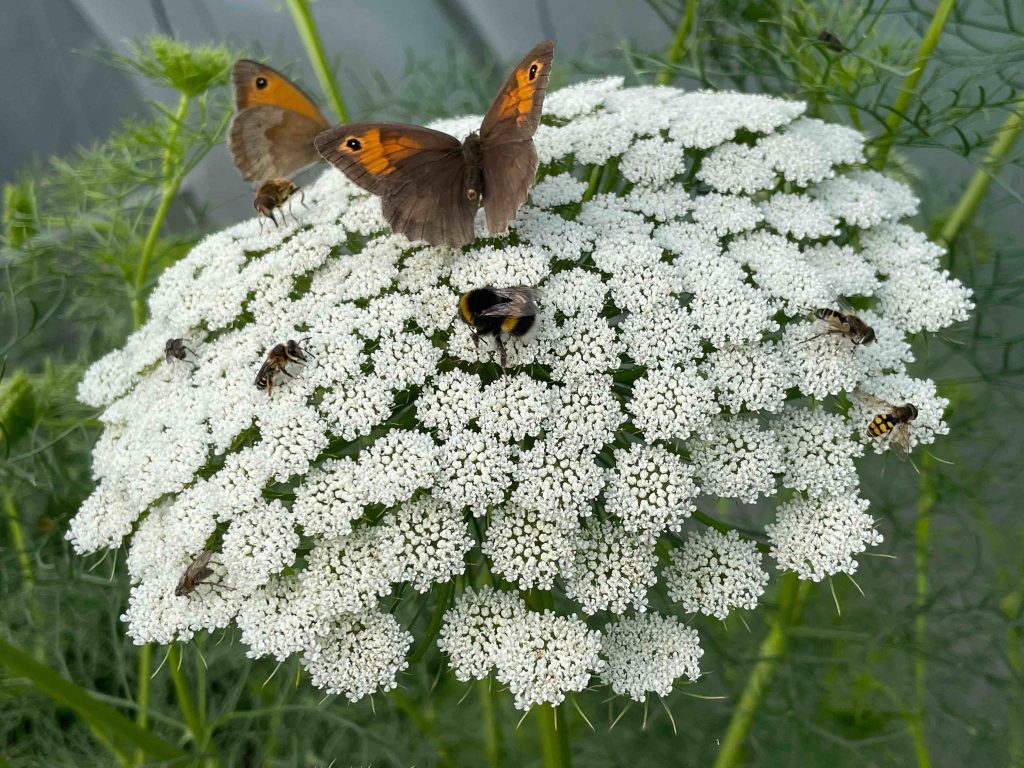
Pollinators – yes of course – the honey bee – but we have about 270 species of bee in the UK! Most of these collect pollen to feed to their larvae – losing some of it on the way, inadvertently cross-pollinating plants in the process.

Most bee species do not form colonies like our 26 species of bumble bee and the honey bee. The other 240 species are solitary – single females make solitary nests in which to rear their offspring. They are generally smaller as individuals than their colonial cousins but this doesn’t mean that they are less important as pollinators – it all depends on how efficiently they collect and transfer pollen. Solitary bees tend to be good at picking up pollen, but bad at holding onto it. In consequence, they are actually responsible for the majority of pollination in the UK, for example, a single red mason bee pollinates 120 times more flowers than a honey bee.
Different solitary bee species make their nests in different locations: in dry soil – you can find their mini spoil heaps like tiny mole hills; in hollow stems – you can help them with leaving some standing stalks; in holes that they excavate in the lime mortar of your walls. None of them will harm you – they do have stings but you’d have to squeeze them in your hand to get hurt.
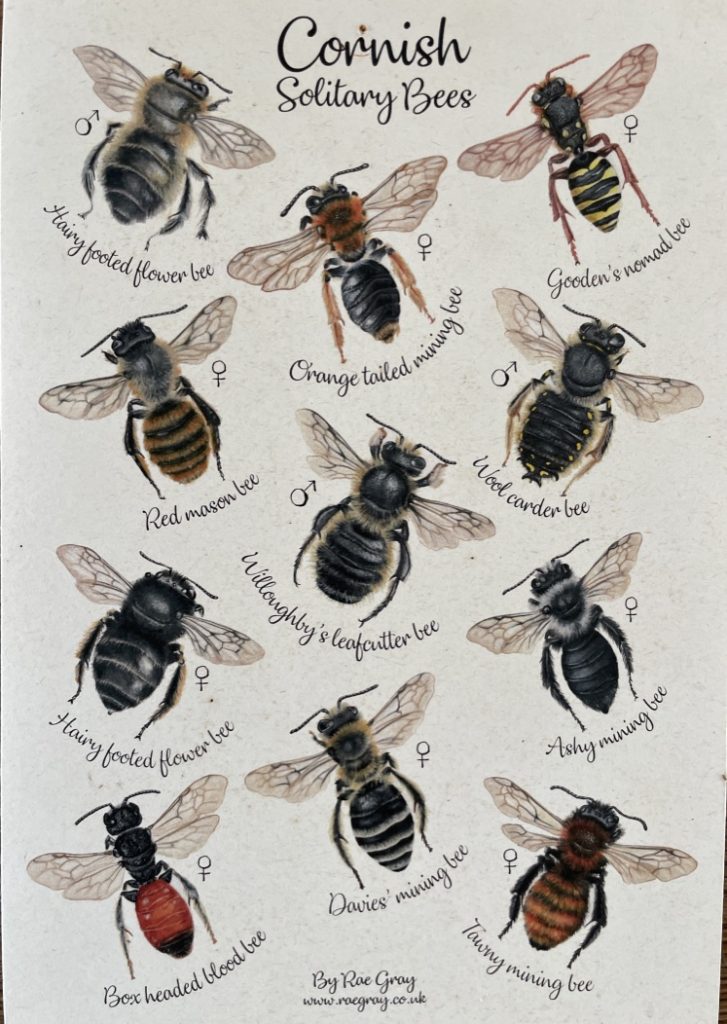
Hoverflies: adult hoverflies are also unsung heroes of the pollinating world with the additional benefit that many have larval stages that predate on garden pests such as aphids, leafhoppers, whitefly and scale insects. Hoverflies are true flies – they have only one pair of wings not two like the wasps and bees. Many mimic wasps and bees, with striped abdomens but they do not have stings or build nests. They can fly prodigious distances, even over water. One of the most common in the UK is the Marmalade Hoverfly which migrates to us from Europe in huge numbers every summer.

Butterflies, moths, wasps and flies don’t collect pollen deliberately but in the search for nectar they do contribute to pollination. That welcome summer tourist, the Hummingbird Hawk Moth is an exception – it manages to steal the nectar without touching down on any pollen.

Predators:
The other ‘Good Bugs’ are predators of ‘Bad Bugs’.
Ground beetles are members of a very large family – the Carabidae with 350 species in Britain and 40,000 worldwide. They are mostly nocturnal predators of invertebrates – with little specificity of their prey. They eat soil-dwelling organisms, slugs, snails, maggots, caterpillars, ants and aphids but also earthworms – so they are largely but not always beneficial for the gardener. Like the rest of the insect population they are suffering substantial decline. Encourage them by leaving some rotting piles of wood, twigs and leaves in a quiet corner in which to breed and hide out in during the day.

Ladybirds and their larvae are voracious eaters of aphids. Of the 40 UK species a few feed on plants but none of these cause significant damage. Many ladybird adults hibernate; they like dense shrubby bushes like box and Hebe in which to stay safe over winter.


Bug hotels designed to provide hibernating and nesting places for beneficial insects are very trendy but, unless these are truly palatial, it is better to be a bit untidy. Leave hollow-stemmed plants not fully cut down or bundled into a corner, leave some rotting wood, a pile of leaves, a window open in the garden shed for butterflies and flies to hibernate – don’t be too tidy.
Bad bugs :
Aphids and other sap suckers
Aphids – greenfly, blackfly and wooly aphids are all sapsuckers – they all have piercing and sucking mouthparts that penetrate the phloem of the plant and suck the sugary juice from them. They are among the most destructive of pests in temperate regions. Despite being so small, they are so damaging because they primarily attack the growing shoots of plants and because they can proliferate so rapidly. This is because they have ‘telescoping generations’ – the females reproduce asexually giving birth to live young that may themselves be already pregnant. Sexual reproduction occurs in the autumn leaving overwintering eggs to kick off the spring population explosion. They cause additional problems by transmitting viruses.
Controlling aphids in the garden is best achieved by promoting predator species – insects like ladybirds and lacewing larvae but also birds. Bluetits travel down my rose border every morning systematically cleaning up. In the greenhouse, you can buy parasitic wasps and ladybird larvae for control. Catching the infection early, the easiest control method is to wipe them off with your fingers or to blast them with the hose.

Photo 9 Mixed aphids on artichoke stem
Lupin aphid is the one aphid I have trouble with here. It is a specific feeder on lupins – both tree and herbaceous – and causes significant damage very quickly. It’s an illegal immigrant from North America that arrived 40 years ago and is now widespread. This is an aphid on steroids – much larger than any of our native species and a distinctly bluey green colour. They absorb alkaloids from the lupin which makes them distasteful to most insect predators and birds. So there is no option other than the disgusting manual squishing or repeated hose blasting.

Other sap suckers include shield bugs and the leafhoppers whose larvae hide in the froth called ‘cuckoo spit’. Neither of these seem to cause significant damage in the garden.
Caterpillars are the larval stage of moths and butterflies. Relatively few cause problems in the garden. The caterpillars of cabbage white butterflies are probably the best known and most common pests of kitchen gardens. The Large White has yellow and black patterned caterpillars and the Small White has velvety green ones. As long as you don’t have acres of brassicas, the best control is to look for the yellow butterfly eggs and scrape them off with a fingernail and pick off any hatched caterpillars as you see them. Caterpillars are valuable food for birds so if they’re not doing too much damage, you can afford to leave some. People grow under fleece for protection but I find this awkward for weeding and the butterflies always manage to get some access and then the caterpillars are protected from predators including you! Cabbage whites also love nasturtiums so I grow some sacrificial ones for the butterflies. There are also biological controls available – pathogenic nematodes that infect and kill the caterpillars but they are sold as a mixture and are not specific so you may inadvertently kill other butterfly and moth larvae.
Box tree moth is another foreign invader, from East Asia. It has trekked across Europe arriving in the UK in 2007 and on the Roseland only in the last couple of years. The moth has wings that are white with a brown margin, the caterpillars are greenish yellow with black stripes and heads. The first sign that you have it though will be leaf damage with webbing over the feeding area. They are voracious feeders and can cause die back and even girdling of sections of the plant. I don’t yet have it in my garden but I’m sure it will come. The only control is hand picking of the caterpillars – a herculean task if you have a number of box topiary or hedges! Together with the advent of box blight, it probably means that we should give up on box altogether.
Sawflies: are a large group, related to the wasps, bees and ants. In Britain there are over 500 species. In many species, the larvae feed on plants by rasping off the surface of leaves – often leaving them transparent – the ‘windowpane effect’. The only ones that cause significant damage to gardeners are the 3 species of gooseberry sawfly which can completely defoliate the plants and thus reduce the crop. Several species of rose sawflies can cause damage early in the year which is unsightly but is outgrown by high summer. Birds are the best predators and access is a problem in a fruit cage so leave the door open for them until the fruit is ripe.

Lily Beetle
I had a glorious 8 years of growing perfect lilies at Crugsillick before the lily beetles found me. Now my first action on a sunny morning in May and June is to go out grooming the lilies on the hunt for the adults of these beautiful Chinese lacquer-coloured beetles. You have to be very sneaky to catch these critters – if they detect your approaching hand, they drop off the lily leaf onto the ground and play dead showing their black undersides which are difficult to spot against the soil. You need to approach slowly, place one hand under the leaf and go for the little ‘b’ with the other so if you fail with one hand it falls into the other. It is worth learning this technique because if they get to lay eggs, the next thing you see is your lilies being systematically stripped of their leaves by their larvae that protect themselves by covering themselves in their own excrement. The only way of dealing with these is to wipe them off, leaf by leaf. I use kitchen paper to reduce the yuk factor!
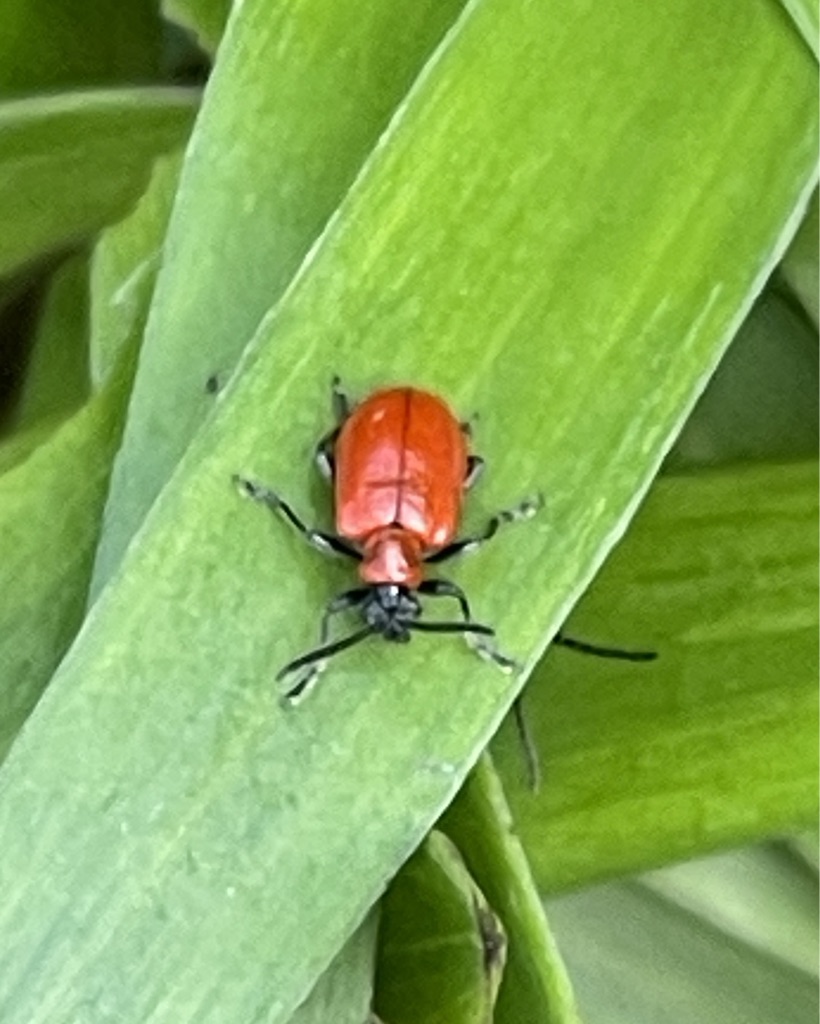

Some new pests have come to bug me in the last 3 years
Gall Midges: are a large group of very small flies that inject their eggs into plant tissues and the feeding larvae cause distortion of the affected part. Many affect specific host plants and plant parts.
Hemerocallis Gall Midge is yet another newcomer, arriving in Britain in 1989 but only reaching Cornwall in the 2020’s – I was an early victim it seems. It affects the flower buds which become short and fat. If you break them open you can see tiny wriggling colourless larvae if you have good eyesight or a magnifying glass. Varieties that flower early in the season are more affected so I have ditched my lovely June-flowering Hemerocallis citrina in favour of July-flowering Hemerocallis Hyperion. Systematically removing the affected buds is keeping it under control at the moment.

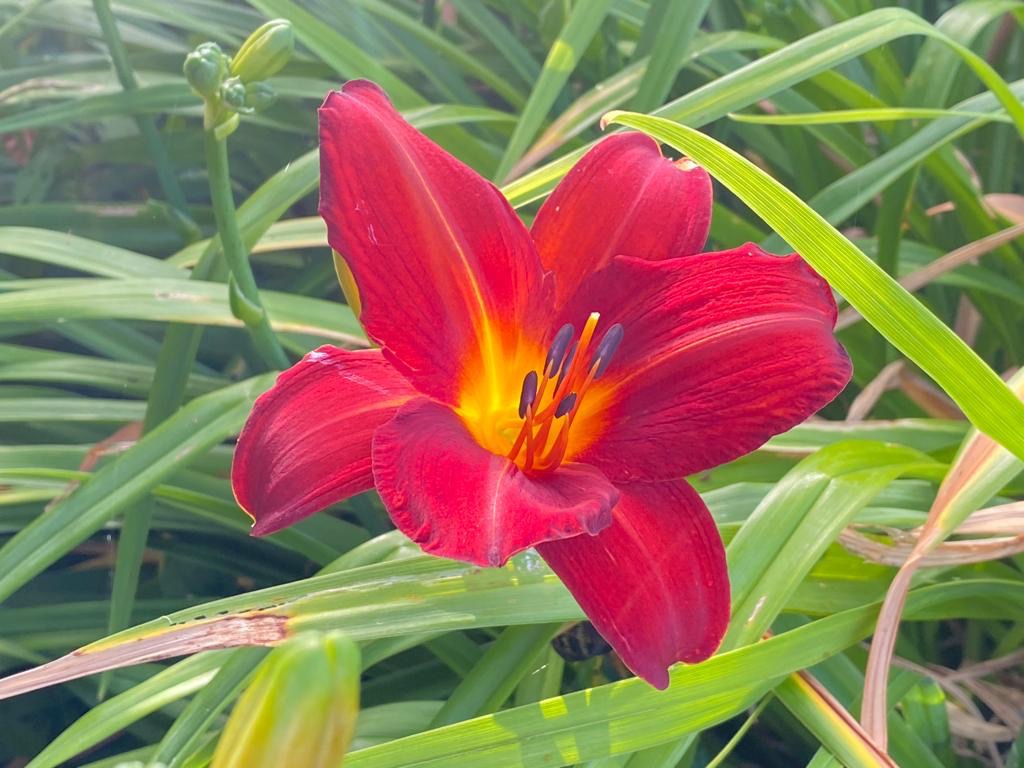
Agapanthus gall midge is the big one for Cornwall – what a disaster! This midge was unknown to science until 2016 and only arrived in my garden last year but by this year there are few unaffected plants. Like the Hemerocallis midge, the fly injects its eggs into the Agapanthus flower bud, the small orange larvae consume and distort the buds and it fails to flower. Unchecked, the entire plant loses its flowers. Again, the only control is to remove and destroy all the affected flower heads to prevent the pupal stage overwintering in the soil. There are no biological or chemical controls known to affect this midge. I fear that this is a very successful pest with a huge host population in the area. We may be losing this iconic summer flower of Cornish gardens.

Fuchsia Gall Mite is another nasty beasty that has appeared in my garden in the last 3 years. The mites are microscopic sap suckers. They secrete chemicals that distort new growth resulting in ugly eruptions instead of flowers. Removing and destroying the affected tissue has helped to control it but I fear that it is yet another pest that will require vigilance to control. There is a predatory mite sold as a biological control but I haven’t tried it yet.
“Big fleas have little fleas upon their backs to bite them, and little fleas have lesser fleas, and so ad infinitum” Swift 1733.

Photo 17 Fuchsia Gall mite
Sign up to The Big Bug Hunt to receive early warning of pests coming your way info@bigbughunt.com
Sign up for the Big Butterfly Count before the 4th August to make a citizen’s science contribution to tracking the populations of these insects. bigbutterflycount@butterfly-conservation.org

